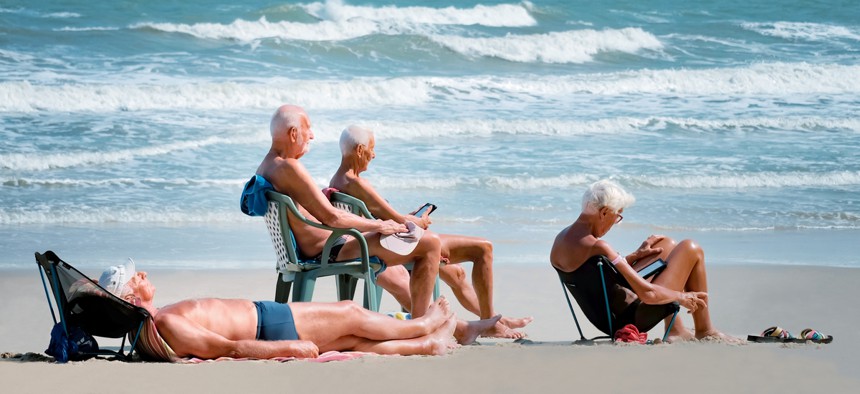Best State for Retirement? The Answer Isn’t Necessarily Florida

The beaches of Florida may not be enough to coax retirees there anymore. Robie Online/Shutterstock
A new ranking did give the retirement mecca a nod, but also flagged some more surprising states.
Though thousands of elderly people migrate south to Florida to retire each year, a new ranking of the best and worst states for retirement shows that other, less obvious places may be better suited to the needs of the greying population.
The rankings, compiled by BankRate, a consumer financial services company, were based on the factors of affordability, crime, culture, weather, and wellness. These created a surprising, Midwest-heavy top five: Nebraska, Iowa, Missouri, South Dakota, and Florida.
Nebraska’s status is particularly amusing given that it was previously ranked as the most boring state and least popular tourist destination in the country—prompting a new tongue-in-cheek tourism slogan: “Honestly, it’s not for everyone.”
In their ranking, Bankrate explored the questions that seniors are likely to consider when retiring. “Should you settle by a bright beach and humming population hub? Or maybe in a place where residents wave to each other and green grass grows?” the report asked. In the end, though, cost would likely be a significant, if not the most important, factor in deciding where to settle after leaving the workforce.
“Where to live is probably one of the most personal decisions one can make because it’s not just about preferences, it’s also about the financial considerations that are associated with it,” wrote Mark Hamrick, a senior economic analyst at Bankrate. Recent studies have shown that almost 25% of Americans do not think they will be able to retire, and about half will reach retirement age without enough savings to quit their jobs.
“The older one gets the more obvious it becomes how well they have been planning for retirement, and, unfortunately, if many Americans haven’t sufficiently saved for retirement then they have to seek at least part-time work in their senior years,” Hamrick continued.
The wellness and affordability aspects of the ranking are also intimately linked for seniors who hope to enroll in Medicare, as the costs associated with certain supplemental plans vary widely across the country. A Medicare Supplement Plan G, for example, has a monthly premium around $286 in Miami, Florida, but costs $90 in Omaha, Nebraska.
“The average social security check is $1,400,” Danielle Roberts, a Medicare insurance expert and co-founder of Boomer Benefits, told NBC News. “That Medicare bill can knock you out of left field. I often see people freak when they find out that Medicare isn’t free.”
Affordability was therefore the factor that carried the heaviest weight in the rankings, and was calculated based on the percentage of people in each state who needed to see a doctor but were prohibited by cost, as well as the state’s income, property, and sales tax rates. Wellness was the next most important consideration, and was based on the number of places per capita that provide services for the elderly, along with the number of health care benchmarks a state achieved or exceeded in the past few years.
Weather, based on average daily temperatures, was tied with culture, based on the number of arts, entertainment, recreation, and dining establishments per capita, as the next most important factors. Crime carried a minimal weight of only 5%, and considered the property and violent crime rates for each state.
Nebraska performed particularly well in the wellness category, meeting or exceeding 61% of nationally monitored health measures, a higher percentage than about two-thirds of other states. Missouri (#3 overall), tied with Michigan (#24) for the most affordable state, followed by Indiana (#29) and Arkansas (#11).
The five worst states for retirement were Maryland, New York, Alaska, Illinois, and Washington. All states finished in the bottom 38 for affordability, and most scored particularly poorly on weather and wellness. All those states, minus Alaska, also happen to be locations where the country’s youngest independent population—millennials—are moving in droves.
About 570,000 adults move to a new state after retiring each year. And palm-strewn Florida, the state with the highest percentage of people above 65, at 19%, is a major destination.
But while it may be seen as the senior capital of the country, Florida’s stake in the retirement community seems to have been slipping even before these rankings were published. A recent survey showed that 42% of those who moved to New Mexico in 2018 did so because of retirement, higher than any other state. For comparison, 38% of people moving to Florida cited retirement.
Will Nebraska see the same retiree surge as New Mexico soon, perhaps surpassing Florida? Possibly, but by the state’s own admission, it’s not for everyone.
Emma Coleman is the assistant editor for Route Fifty.
NEXT STORY: Becoming the Lionfish King






